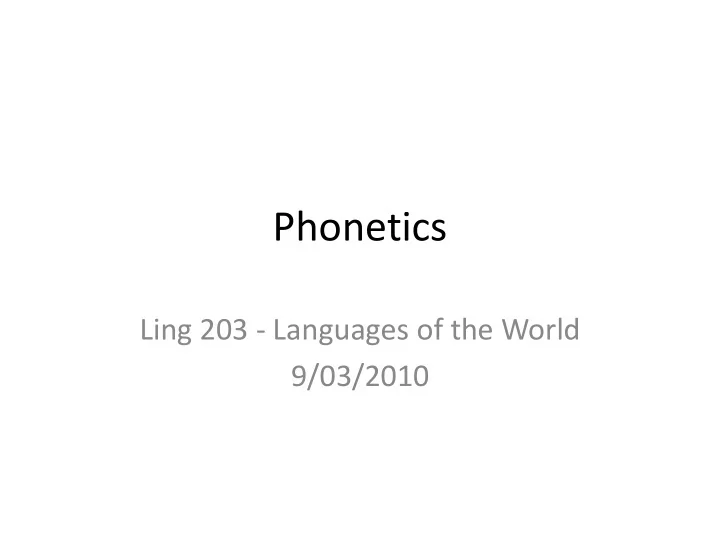

Phonetics Ling 203 - Languages of the World 9/03/2010
What is phonetics? Definition: The study of speech sounds Branches: 1. acoustic (the physics of sound) 2. auditory (how the ear processes sound) 3. articulatory (how we produce speech sounds)
Why do we need a phonetic alphabet?
Why do we need a phonetic alphabet? English: Czech <c> [k] <c> [ts] cat co ‘what’ cord Václav (name) cup třicet ‘thirty’
Why do we need a phonetic alphabet? In English: <a> ball <t> tall sand stop make later patience train
Why do we need a phonetic alphabet? In English: <ea> health each wealth meal <ck> back bucket
Why do we need a phonetic alphabet? In English: <e> late < h> hour < k> knee
Why do we need a phonetic alphabet? In English: Vowel letters: <a, e, i, o, u> Vowel sounds: monophthongs: beat, bit, bate, bet, bat, boot, bull, boat, bought, (ro)bot, but, bulemic, *bird diphthongs: bow, bout, bide, bike, boy
International Phonetic Alphabet (IPA) • single alphabet with symbols to represent sounds from all languages • one-to-one correspondence between sounds and symbols • includes special symbols to indicate minor variation and things like tone, stress, etc. • most symbols from Latin and Greek alphabets
International Phonetic Alphabet (IPA) This is only part of the IPA. A full chart will be handed out later.
International Phonetic Alphabet (IPA) • IPA is not the only phonetic alphabet used, though it is the most common
Describing English Consonants We can distinguish all English consonants from each other using three features: 1. place of articulation 2. manner of articulation 3. voicing
Places of Articulation • refers to which parts of the vocal tract are used to make consonant sounds Source: Ladefoged & Maddieson (1996:13)
Places of Articulation English uses the following places of articulation: 1. bilabial 2. labiodental 3. interdental 4. alveolar 5. postalveolar 6. palatal 7. velar 8. glottal
Manners of Articulation • refers to how the air is manipulated when makings sounds
Manners of Articulation English uses the following manners of articulation 1. plosive (= stop) 2. fricative 3. affricate 4. nasal 5. approximant 6. lateral approximant 7. flap
Manners of Articulation Rather than using the terms “approximant” and “lateral approximant”, you will frequently see the following: • liquid = [l] and [ɹ] • glide = [j] and [w]
Voicing • refers to whether the vocal cords (=glottis) are vibrating or not when making sounds • lets us distinguish many plosives, affricates and fricatives in English • (technically, this could be considered a ‘manner’)
Voicing Consonant sounds can be: 1. voiced (vibration) 2. voiceless/unvoiced (no vibration)
The Consonants of English bilabial labiodental interdental alveolar post-alveolar palatal velar glottal ʔ plosive p b t d k g t ʃ d ʒ affricate θ ð ʃ ʒ fricative f v s z h ɾ flap ŋ nasal m n ɹ approximant w j lateral l approximant Notes: The handout I gave you lists [w] as a velar sound. Actually, it is a co-articulated sound, in this case using two places of articulation at the same time. In reality, it is labio-velar, so there is no perfect place to put it. Also note that I include a glottal plosive [ʔ] that was not on the handout. This is usually called a ‘glottal stop’. When writing about English, people frequently use [r] in place of [ ɹ ]. Technically, this is not correct ([r] is a different sound in the IPA), but be aware that you will see it.
Describing English Vowels We can distinguish most English consonants from each other using three features: 1. height 2. frontness/backness 3. tenseness Additionally, we frequently talk about roundedness of vowels, though this is less important in English than other languages.
Height • refers to the relative height of the relevant part of the tongue when producing a sound
Height • English vowels can be 1. high 2. mid 3. low
Frontness/Backness • refers to the part of the mouth part of the tongue move toward
Frontness/Backness English vowels can be 1. front 2. central 3. back
Tenseness • refers to whether the lip/tongue muscles are relatively tensed or relaxed when producing a vowel sound
Tenseness English vowels can be 1. tense 2. lax
Roundedness • refers to whether the lips are rounded or not when producing a vowel sound
Roundedness English vowels can be 1. round(ed) 2. unround(ed)
The Vowels of English • The chart below shows the monophthongs of English Modified from Language Files 10 . *[e] and [o] are actually pronounced as diphthongs in English, but we will ignore this.
Other languages? • The distinctions here are relevant for English. • Other languages may have distinctions English doesn’t have. • Not all languages have all the distinctions that English has.
References Ladefoged, Peter & Ian Maddieson. (1996). The Sounds of the World’s Languages . Malden, MA: Blackwell Publishers Inc. Bergmann, A., K. Hall, & S. Ross. (Eds.). Language Files 10: Materials for an Introduction to Language and Linguistics . Columbus, OK: The Ohio State University Press.
Recommend
More recommend